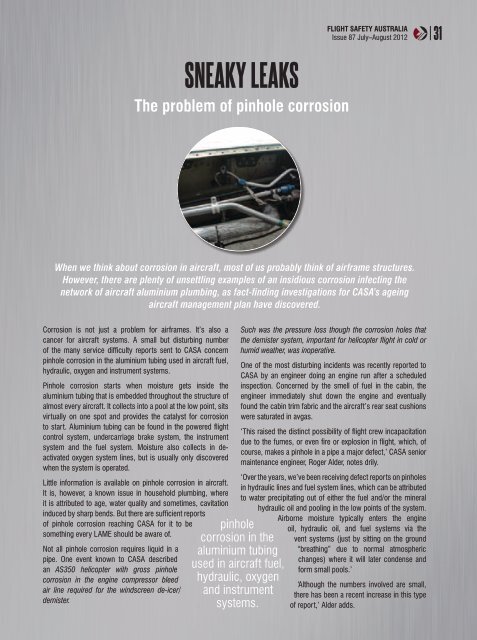jul-aug2012
Create successful ePaper yourself
Turn your PDF publications into a flip-book with our unique Google optimized e-Paper software.
Flight Safety Australia<br />
Issue 87 July–August 2012<br />
31<br />
Sneaky leaks<br />
The problem of pinhole corrosion<br />
When we think about corrosion in aircraft, most of us probably think of airframe structures.<br />
However, there are plenty of unsettling examples of an insidious corrosion infecting the<br />
network of aircraft aluminium plumbing, as fact-finding investigations for CASA’s ageing<br />
aircraft management plan have discovered.<br />
Corrosion is not just a problem for airframes. It’s also a<br />
cancer for aircraft systems. A small but disturbing number<br />
of the many service difficulty reports sent to CASA concern<br />
pinhole corrosion in the aluminium tubing used in aircraft fuel,<br />
hydraulic, oxygen and instrument systems.<br />
Pinhole corrosion starts when moisture gets inside the<br />
aluminium tubing that is embedded throughout the structure of<br />
almost every aircraft. It collects into a pool at the low point, sits<br />
virtually on one spot and provides the catalyst for corrosion<br />
to start. Aluminium tubing can be found in the powered flight<br />
control system, undercarriage brake system, the instrument<br />
system and the fuel system. Moisture also collects in deactivated<br />
oxygen system lines, but is usually only discovered<br />
when the system is operated.<br />
Little information is available on pinhole corrosion in aircraft.<br />
It is, however, a known issue in household plumbing, where<br />
it is attributed to age, water quality and sometimes, cavitation<br />
induced by sharp bends. But there are sufficient reports<br />
of pinhole corrosion reaching CASA for it to be<br />
something every LAME should be aware of.<br />
Not all pinhole corrosion requires liquid in a<br />
pipe. One event known to CASA described<br />
an AS350 helicopter with gross pinhole<br />
corrosion in the engine compressor bleed<br />
air line required for the windscreen de-icer/<br />
demister.<br />
pinhole<br />
corrosion in the<br />
aluminium tubing<br />
used in aircraft fuel,<br />
hydraulic, oxygen<br />
and instrument<br />
systems.<br />
Such was the pressure loss though the corrosion holes that<br />
the demister system, important for helicopter flight in cold or<br />
humid weather, was inoperative.<br />
One of the most disturbing incidents was recently reported to<br />
CASA by an engineer doing an engine run after a scheduled<br />
inspection. Concerned by the smell of fuel in the cabin, the<br />
engineer immediately shut down the engine and eventually<br />
found the cabin trim fabric and the aircraft’s rear seat cushions<br />
were saturated in avgas.<br />
‘This raised the distinct possibility of flight crew incapacitation<br />
due to the fumes, or even fire or explosion in flight, which, of<br />
course, makes a pinhole in a pipe a major defect,’ CASA senior<br />
maintenance engineer, Roger Alder, notes drily.<br />
‘Over the years, we’ve been receiving defect reports on pinholes<br />
in hydraulic lines and fuel system lines, which can be attributed<br />
to water precipitating out of either the fuel and/or the mineral<br />
hydraulic oil and pooling in the low points of the system.<br />
Airborne moisture typically enters the engine<br />
oil, hydraulic oil, and fuel systems via the<br />
vent systems (just by sitting on the ground<br />
“breathing” due to normal atmospheric<br />
changes) where it will later condense and<br />
form small pools.’<br />
‘Although the numbers involved are small,<br />
there has been a recent increase in this type<br />
of report,’ Alder adds.

















